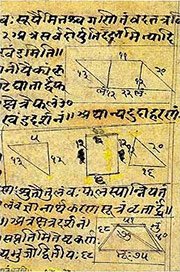Tribhaga, Tribhāgā, Tribhāga, Tri-bhaga: 9 definitions
Introduction:
Tribhaga means something in Hinduism, Sanskrit. If you want to know the exact meaning, history, etymology or English translation of this term then check out the descriptions on this page. Add your comment or reference to a book if you want to contribute to this summary article.
In Hinduism
Purana and Itihasa (epic history)
Source: Cologne Digital Sanskrit Dictionaries: The Purana IndexTribhāgā (त्रिभागा).—A river from the Mahendra hills.*
- * Matsya-purāṇa 114. 31.

The Purana (पुराण, purāṇas) refers to Sanskrit literature preserving ancient India’s vast cultural history, including historical legends, religious ceremonies, various arts and sciences. The eighteen mahapuranas total over 400,000 shlokas (metrical couplets) and date to at least several centuries BCE.
Jyotisha (astronomy and astrology)
Source: Wisdom Library: Brihat Samhita by VarahamihiraTribhāga (त्रिभाग) refers to a “third part” (of the sky), according to the Bṛhatsaṃhitā (chapter 11), an encyclopedic Sanskrit work written by Varāhamihira mainly focusing on the science of ancient Indian astronomy astronomy (Jyotiṣa).—Accordingly, “Kapāla Ketu is visible on new-moon days; its tail is of the colour of smoke; its course lies through the eastern half of the visible hemisphere; when it appears mankind will suffer from hunger, death, drought and disease. Raudra Ketu is a comet resembling the dagger’s end and is of a dull red colour; it appears in the south-east and travels through a third of the sky [i.e., tribhāga-gāmī] and produces the same effects as the Kapāla Ketu”.

Jyotisha (ज्योतिष, jyotiṣa or jyotish) refers to ‘astronomy’ or “Vedic astrology” and represents the fifth of the six Vedangas (additional sciences to be studied along with the Vedas). Jyotisha concerns itself with the study and prediction of the movements of celestial bodies, in order to calculate the auspicious time for rituals and ceremonies.
Ganitashastra (Mathematics and Algebra)
Source: archive.org: Hindu MathematicsTribhāga (त्रिभाग) or Tryaṃśa refers to “three-parts” (i.e., one-third) in Bhinna (“fractions”) and Bhāga (“unit fractions”), which refers to one of the twenty operations (logistics) of pāṭīgaṇita (“science of calculation which requires the use of writing material—the board”), according to Pṛthudakasvāmī’s commentary on the Brāhmasphuṭasiddhānta by Brahmagupta, a Sanskrit treatise on ancient Indian mathematics (gaṇita-śāstra) and astronomy from the 7th century.—In the Śulba, unit fractions are denoted by the use of a cardinal number with the term bhāga or aṃśa; thus pañcadaśa-bhāga (“fifteen-parts”) is equivalent to one-fifteenth, sapta-bhāga (“seven-parts”) is equivalent to one-seventh, and so on [e.g., tribhāga].

Ganitashastra (शिल्पशास्त्र, gaṇitaśāstra) refers to the ancient Indian science of mathematics, algebra, number theory, arithmetic, etc. Closely allied with astronomy, both were commonly taught and studied in universities, even since the 1st millennium BCE. Ganita-shastra also includes ritualistic math-books such as the Shulba-sutras.
Languages of India and abroad
Sanskrit dictionary
Source: DDSA: The practical Sanskrit-English dictionaryTribhāga (त्रिभाग).—
1) the third part; त्रिभागं ब्रह्महत्यायाः कन्या प्राप्नोति दुष्यती (tribhāgaṃ brahmahatyāyāḥ kanyā prāpnoti duṣyatī) Mahābhārata (Bombay) 12.165.42.
2) the third part of a sign of the zodiac.
Derivable forms: tribhāgaḥ (त्रिभागः).
Tribhāga is a Sanskrit compound consisting of the terms tri and bhāga (भाग).
Source: Cologne Digital Sanskrit Dictionaries: Benfey Sanskrit-English DictionaryTribhāga (त्रिभाग).—m. a 3rd part, [Harivaṃśa, (ed. Calc.)] 8887.
Tribhāga is a Sanskrit compound consisting of the terms tri and bhāga (भाग).
Source: Cologne Digital Sanskrit Dictionaries: Cappeller Sanskrit-English DictionaryTribhāga (त्रिभाग).—[masculine] the third [particle]
Source: Cologne Digital Sanskrit Dictionaries: Monier-Williams Sanskrit-English Dictionary1) Tribhāga (त्रिभाग):—[=tri-bhāga] [from tri] m. the 3rd part, [Harivaṃśa; Varāha-mihira’s Bṛhat-saṃhitā; Rājataraṅgiṇī; Kātyāyana-śrauta-sūtra [Scholiast or Commentator]]
2) [v.s. ...] the 3rd part (of the eye sending a particular side-glance), [Kādambarī; Harṣacarita vii; Bālarāmāyaṇa iii, 49]
3) [v.s. ...] the 3rd part of a zodiacal sign, [Varāha-mihira’s Bṛhajjātaka]
4) [v.s. ...] three-fourths, [Pañcarātra i, 14, 50.]
[Sanskrit to German]
Sanskrit, also spelled संस्कृतम् (saṃskṛtam), is an ancient language of India commonly seen as the grandmother of the Indo-European language family (even English!). Closely allied with Prakrit and Pali, Sanskrit is more exhaustive in both grammar and terms and has the most extensive collection of literature in the world, greatly surpassing its sister-languages Greek and Latin.
See also (Relevant definitions)
Starts with: Tribhaga-abhyantara-siddhi.
Ends with: Dramma-tribhaga, Nayanatribhaga, Ratribhaga, Stribhaga.
Full-text: Dramma-tribhaga, Netratribhagabrahmayashasvin, Tribhaga-abhyantara-siddhi, Tribhoga-abhyantara, Tri-bhoga, Gamin, Tryamsha, Viyat, Una.
Relevant text
Search found 2 books and stories containing Tribhaga, Tri-bhaga, Tri-bhāga, Tribhāgā, Tribhāga; (plurals include: Tribhagas, bhagas, bhāgas, Tribhāgās, Tribhāgas). You can also click to the full overview containing English textual excerpts. Below are direct links for the most relevant articles:
Bhakti-rasamrta-sindhu (by Śrīla Rūpa Gosvāmī)
Verse 2.4.161 < [Part 4 - Transient Ecstatic Disturbances (vyābhicāri-bhāva)]
Chaitanya Bhagavata (by Bhumipati Dāsa)
Verse 2.8.62-063 < [Chapter 8 - The Manifestation of Opulences]
Verse 3.3.61 < [Chapter 3 - Mahāprabhu’s Deliverance of Sarvabhauma, Exhibition of His Six-armed Form, and Journey to Bengal]